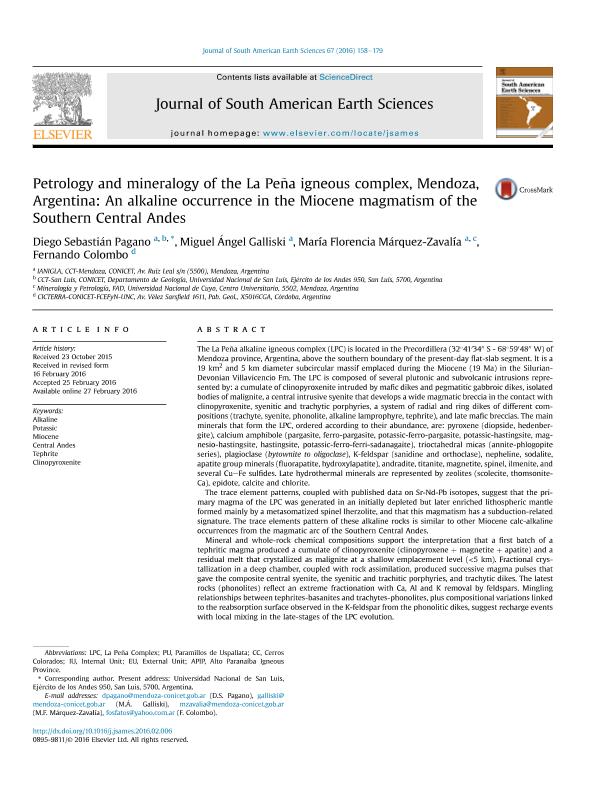Mostrar el registro sencillo del ítem
dc.contributor.author
Pagano Género, Diego Sebastián

dc.contributor.author
Galliski, Miguel Angel

dc.contributor.author
Marquez Zavalia, Maria Florencia

dc.contributor.author
Colombo, Fernando

dc.date.available
2018-05-04T18:25:16Z
dc.date.issued
2016-04
dc.identifier.citation
Pagano Género, Diego Sebastián; Galliski, Miguel Angel; Marquez Zavalia, Maria Florencia; Colombo, Fernando; Petrology and mineralogy of the La Peña igneous complex, Mendoza, Argentina: An alkaline occurrence in the Miocene magmatism of the Southern Central Andes; Pergamon-Elsevier Science Ltd; Journal of South American Earth Sciences; 67; 4-2016; 158-179
dc.identifier.issn
0895-9811
dc.identifier.uri
http://hdl.handle.net/11336/44187
dc.description.abstract
The La Peña alkaline igneous complex (LPC) is located in the Precordillera (32°41´34″ S - 68°59´48″ W) of Mendoza province, Argentina, above the southern boundary of the present-day flat-slab segment. It is a 19 km2 and 5 km diameter subcircular massif emplaced during the Miocene (19 Ma) in the Silurian-Devonian Villavicencio Fm. The LPC is composed of several plutonic and subvolcanic intrusions represented by: a cumulate of clinopyroxenite intruded by mafic dikes and pegmatitic gabbroic dikes, isolated bodies of malignite, a central intrusive syenite that develops a wide magmatic breccia in the contact with clinopyroxenite, syenitic and trachytic porphyries, a system of radial and ring dikes of different compositions (trachyte, syenite, phonolite, alkaline lamprophyre, tephrite), and late mafic breccias. The main minerals that form the LPC, ordered according to their abundance, are: pyroxene (diopside, hedenbergite), calcium amphibole (pargasite, ferro-pargasite, potassic-ferro-pargasite, potassic-hastingsite, magnesio-hastingsite, hastingsite, potassic-ferro-ferri-sadanagaite), trioctahedral micas (annite-phlogopite series), plagioclase (bytownite to oligoclase), K-feldspar (sanidine and orthoclase), nepheline, sodalite, apatite group minerals (fluorapatite, hydroxylapatite), andradite, titanite, magnetite, spinel, ilmenite, and several Cu-Fe sulfides. Late hydrothermal minerals are represented by zeolites (scolecite, thomsonite-Ca), epidote, calcite and chlorite.The trace element patterns, coupled with published data on Sr-Nd-Pb isotopes, suggest that the primary magma of the LPC was generated in an initially depleted but later enriched lithospheric mantle formed mainly by a metasomatized spinel lherzolite, and that this magmatism has a subduction-related signature. The trace elements pattern of these alkaline rocks is similar to other Miocene calc-alkaline occurrences from the magmatic arc of the Southern Central Andes.Mineral and whole-rock chemical compositions support the interpretation that a first batch of a tephritic magma produced a cumulate of clinopyroxenite (clinopyroxene + magnetite + apatite) and a residual melt that crystallized as malignite at a shallow emplacement level (<5 km). Fractional crystallization in a deep chamber, coupled with rock assimilation, produced successive magma pulses that gave the composite central syenite, the syenitic and trachitic porphyries, and trachytic dikes. The latest rocks (phonolites) reflect an extreme fractionation with Ca, Al and K removal by feldspars. Mingling relationships between tephrites-basanites and trachytes-phonolites, plus compositional variations linked to the reabsorption surface observed in the K-feldspar from the phonolitic dikes, suggest recharge events with local mixing in the late-stages of the LPC evolution.The emplacement of the LPC melts at a shallow crustal level was favored by the aperture of extensional NNW-SSE fractures genetically linked to a local brittle shear zone, active at 18-19 Ma during a strong compressional event, that initiated the regime of flat-slab subduction in this part of the Andes.
dc.format
application/pdf
dc.language.iso
eng
dc.publisher
Pergamon-Elsevier Science Ltd

dc.rights
info:eu-repo/semantics/openAccess
dc.rights.uri
https://creativecommons.org/licenses/by-nc-sa/2.5/ar/
dc.subject
Alkaline
dc.subject
Central Andes
dc.subject
Clinopyroxenite
dc.subject
Miocene
dc.subject
Potassic
dc.subject
Tephrite
dc.subject.classification
Meteorología y Ciencias Atmosféricas

dc.subject.classification
Ciencias de la Tierra y relacionadas con el Medio Ambiente

dc.subject.classification
CIENCIAS NATURALES Y EXACTAS

dc.title
Petrology and mineralogy of the La Peña igneous complex, Mendoza, Argentina: An alkaline occurrence in the Miocene magmatism of the Southern Central Andes
dc.type
info:eu-repo/semantics/article
dc.type
info:ar-repo/semantics/artículo
dc.type
info:eu-repo/semantics/publishedVersion
dc.date.updated
2018-05-02T17:40:26Z
dc.journal.volume
67
dc.journal.pagination
158-179
dc.journal.pais
Estados Unidos

dc.description.fil
Fil: Pagano Género, Diego Sebastián. Universidad Nacional de San Luis. Facultad de Ciencias Físico- Matemáticas y Naturales; Argentina. Consejo Nacional de Investigaciones Científicas y Técnicas. Centro Científico Tecnológico Conicet - Mendoza. Instituto Argentino de Nivología, Glaciología y Ciencias Ambientales. Provincia de Mendoza. Instituto Argentino de Nivología, Glaciología y Ciencias Ambientales. Universidad Nacional de Cuyo. Instituto Argentino de Nivología, Glaciología y Ciencias Ambientales; Argentina
dc.description.fil
Fil: Galliski, Miguel Angel. Consejo Nacional de Investigaciones Científicas y Técnicas. Centro Científico Tecnológico Conicet - Mendoza. Instituto Argentino de Nivología, Glaciología y Ciencias Ambientales. Provincia de Mendoza. Instituto Argentino de Nivología, Glaciología y Ciencias Ambientales. Universidad Nacional de Cuyo. Instituto Argentino de Nivología, Glaciología y Ciencias Ambientales; Argentina
dc.description.fil
Fil: Marquez Zavalia, Maria Florencia. Consejo Nacional de Investigaciones Científicas y Técnicas. Centro Científico Tecnológico Conicet - Mendoza. Instituto Argentino de Nivología, Glaciología y Ciencias Ambientales. Provincia de Mendoza. Instituto Argentino de Nivología, Glaciología y Ciencias Ambientales. Universidad Nacional de Cuyo. Instituto Argentino de Nivología, Glaciología y Ciencias Ambientales; Argentina
dc.description.fil
Fil: Colombo, Fernando. Consejo Nacional de Investigaciones Científicas y Técnicas. Centro Científico Tecnológico Conicet - Córdoba. Centro de Investigaciones en Ciencias de la Tierra. Universidad Nacional de Córdoba. Facultad de Ciencias Exactas Físicas y Naturales. Centro de Investigaciones en Ciencias de la Tierra; Argentina
dc.journal.title
Journal of South American Earth Sciences

dc.relation.alternativeid
info:eu-repo/semantics/altIdentifier/url/https://www.sciencedirect.com/science/article/pii/S0895981116300177
dc.relation.alternativeid
info:eu-repo/semantics/altIdentifier/doi/http://dx.doi.org/10.1016/j.jsames.2016.02.006
Archivos asociados
